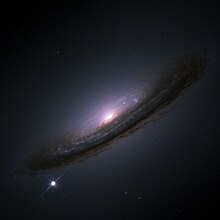Hubble bubble (astronomy)
In accordance with the Copernican principle that the Earth is not in a central, specially favored position, one would expect that measuring this constant at any point in the universe would yield the same value.
If, on the other hand, Earth were at or near the center of a very low-density region of interstellar space (a relative void), the local expansion would be faster due to the lack of nearby mass to slow it down.
[6] In 2007, Conley et al. examined the SNe Ia color data comparisons while taking into account the effect of cosmic dust in external galaxies.
[2] In 2010, Moss et al. analyzed the Hubble Bubble model although without using that name,[1] saying "The suggestion that we occupy a privileged position near the center of a large, nonlinear, and nearly spherical void has recently attracted much attention as an alternative to dark energy.
"[3] Local void models propose a large area of lower than average density, so they ordinarily make or imply stochastic predictions that can be falsified by astronomical surveys.
